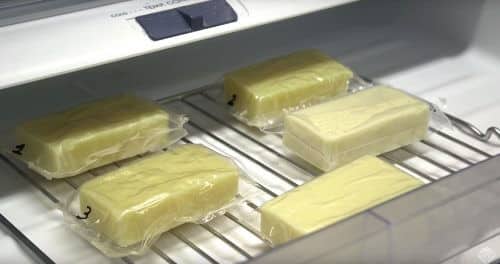
[Translation by Dr. Nachmani Moshe]
Most of the food products sold in supermarkets come to us wrapped in plastic and nylon packaging. This situation not only creates a large amount of waste that cannot be recycled or biodegradable, but these wrappers are not so effective in preventing food from spoiling over time. Scientists are now introducing packaging made from milk proteins that solves these problems - and is even edible.
"The packages made of proteins are an effective barrier against oxygen and help prevent food spoilage. When we use them for food packaging, they will be able to prevent the food from spoiling during distribution," says lead researcher Peggy Tomasula. The spoilage of food is only one aspect - today, most food packaging is based on materials derived from petroleum, materials that are not sustainable. In addition, these materials do not decompose in nature, so they may generate tons of plastic waste that remains buried in the ground for many years.
In order to create better packaging solutions, researchers at the US Department of Agriculture are developing an environmentally friendly packaging consisting of the milk protein casein. This packaging, based on the protein casein, is 500 times more effective than plastic in preventing the penetration of oxygen into the food, and since it is made from milk, the wrapping is also biodegradable, sustainable and even edible. Several types of edible packaging are already commercially available on the market, but these are made of starch, which is a more porous material and allows oxygen to penetrate through its micro-nozzles. On the other hand, the packaging derived from the milk proteins has smaller pores and therefore they form a more sealed network to prevent the penetration of oxygen. Although the researchers' first attempts to use pure casein produced a strong and effective oxygen blocker, the material itself was not easy to handle and dissolved in water too quickly. In the next step, the researchers added another protein to the casein, pectin (derived from citrus fruits), and the packaging became stronger and even more resistant to moisture and high temperatures.
After several other improvements, the innovative packaging became similar in appearance to the plastic wraps sold in supermarkets, but it is less stretchable. The substance itself is edible and consists almost entirely of proteins. Later, it will be possible to add nutritional supplements to the main substance, for example vitamins, friendly bacteria (probiotics) and food supplements. The substance itself has no taste, but the researchers claim that it will be possible to incorporate flavoring substances into it as well. "The packaging applications of this material are inexhaustible," says the lead researcher. "We are currently looking at applications such as edible food wrappers for ready-to-eat meals. For example, in the individually wrapped slices of cheese, a large amount of plastic is used - and we are interested in correcting this situation."
In addition to using this material as food packaging, the casein coating could be sprayed onto the food itself, such as cornflakes or dessert bars. At the moment, the cornflakes retain their crispness in milk thanks to a coating of sugar. Instead of all that sugar, manufacturers could spray coatings of casein proteins to prevent the flakes from turning into moisture sponges. The coating spray can also be used in pizza packaging to prevent grease and oil stains from reaching the package. The research group is currently developing a prototype of the coating for a small company in Texas, and the lead researcher says their development is already generating a lot of interest among other companies as well. The research group plans to continue making improvements to the product and it is expected that it will reach the shelves within 3 years.
The researchers are testing their milk protein-based coating as packaging, for example, for cheese slices.
For information on the website of the American Chemical Society

6 תגובות
A question that I did not find an answer to in the article:
What will the edible wrappers be wrapped in?
The question is what is more polluting, the production and recycling of the original plastic packaging, or the raising of cows and the production of the packaging based on milk protein. They only show the end product and how easy it is to get rid of, but not the process.
Now we will wait for the permission of ACM to implement an important development?
Shimon, the normal gelatin made from animal remains is not kosher,
The kosher gelatin is made from fish bones.
Lorem Ipsum
You touched on a very interesting point about the Mitzvah Observers.
In my opinion (as a mitzvot observant, however, I am not knowledgeable in halacha) since it is only a protein and not the milk itself, it is possible and halachically permissible to eat this protein. There is a halachic precedent for this, the gelatin, even though its source is produced from animals that are not kosher, remains for its consumption because the source material has lost its actual form and "new faces" have come here.
Vegans may not be very happy with this development as far as the packaging or coating of plant-based foods is concerned. Religious Jews may also be displeased when it comes to coating a chicken in horror milk.